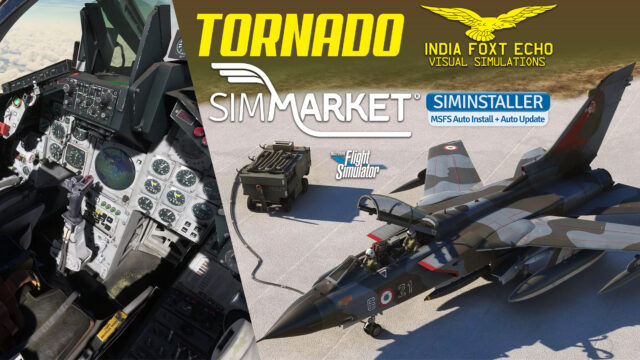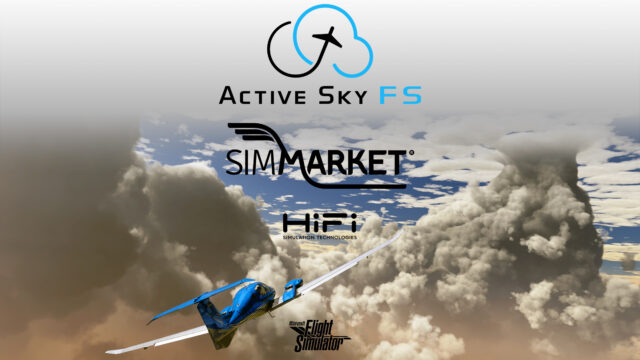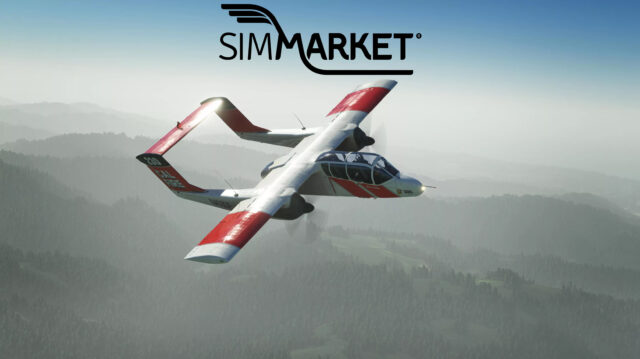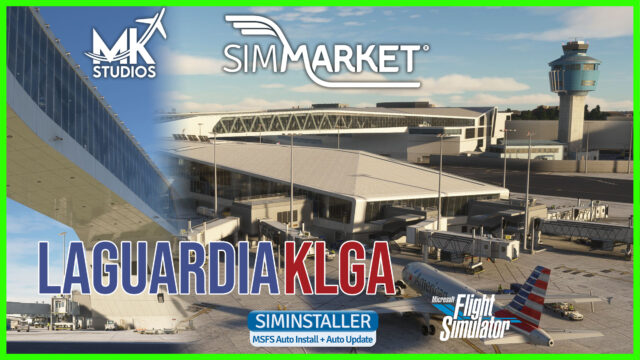 Peter Hayes, our staff reviewer located in Australia starts this review with his usual quick summary: ” This is a nice rendering of the Wittman Tailwinds —W8/W10 (aka “The Flying Carpet”) which is a popular home build 2-seat light aircraft with outstanding performance. The first W8 was launched in 1954 with the W10 appearing some time later. It’s impossible to know how many were actually built but well over 1,000 plans have been sold. Unfortunately, designer Steve Wittman and his wife were killed April 27, 1995 when their “O&O Special” crashed. (Wikipedia) The models look good and the instrumentation is comprehensive, clear and easy to read. These little planes are fast, 200 mph from the W10, easy to fly, very manoeuvrable, cheap to run, and you can buy one for around $US 25,000. You can even carry a passenger!! A Lamborghini or Ferrari that would equal its performance will set you back several hundred thousand dollars!! This is a high wing tail dragger but Bill has also included a W10 in trigear configuration. Loved all 3!”
Peter Hayes, our staff reviewer located in Australia starts this review with his usual quick summary: ” This is a nice rendering of the Wittman Tailwinds —W8/W10 (aka “The Flying Carpet”) which is a popular home build 2-seat light aircraft with outstanding performance. The first W8 was launched in 1954 with the W10 appearing some time later. It’s impossible to know how many were actually built but well over 1,000 plans have been sold. Unfortunately, designer Steve Wittman and his wife were killed April 27, 1995 when their “O&O Special” crashed. (Wikipedia) The models look good and the instrumentation is comprehensive, clear and easy to read. These little planes are fast, 200 mph from the W10, easy to fly, very manoeuvrable, cheap to run, and you can buy one for around $US 25,000. You can even carry a passenger!! A Lamborghini or Ferrari that would equal its performance will set you back several hundred thousand dollars!! This is a high wing tail dragger but Bill has also included a W10 in trigear configuration. Loved all 3!”
Read on for more details.
In the Sim
Settings: In the Select aircraft menu in FSX you will see a new tab for Lionheart and this allows the choice of all 3 variants and 23 repaints. I tested all 3 variants as part of this review. Initially I loaded one of the Tailwind Variants in FSX to ensure it ran OK, then closed FSX and ran a “Complete Name” defrag with O&O ver 11.0.
The Guide: You get one manual which has 21 “sheets” – not pages. The manual is simple and small with lots of illustrations and pictures and it will take less than 20 minutes to read and assimilate. It describes all of the features of this pocket rocket. The manual only describes the W8 and W10 tail-dragger models, the Tri-gear model is described on the lionheart website. No doubt we will see an updated manual in the near future.
The Viz
The Lionheart Wittman Tailwinds have been faithfully reproduced, the first impression is that the models look a little “square” but open up a picture of a real Wittman and you can see how much attention has been paid to detail. The doors open for easy access (this is a 2-seater up front, so it’s great that both doors open and close), you can pull down a sun cover for the panel and a roof cover to stop the pilot getting sunburnt. Lionheart has faithfully reproduced the Wittman’s patented tapered spring steel landing gear. And it’s great to see this “flexing” as you taxi across the rough areas of a landing strip. The Tailwind is a high wing type with a fixed pitch 3 bladed propeller on all 3 variants. The two tails draggers have good all round visibility and can be steered by judicious use of the left and right and brakes. The 3 models have variants with or without “wheel pants”. There two flaps settings and the flaps deploy with a satisfying thunk! I think that Lionheart have done a great job on the visual splendour of this plane.
The Variants:
You get quite a choice in the base package and Lionheart provide repainting tips for the series.
Instruments in the Interior:Â The cockpit is well appointed with the usual basic instruments plus some quite comprehensive navigation, autopilot, and transponder features, together with a custom GPS and a virtual apple iphone. The W8 and W10 have different instruments with the W8 being “simpler”. The instruments are very clear and yes there is a 2-D panel for all those simmers that prefer 2D over 3D. There are four trim themes, black leather, black textured cloth, rustic brown leather and a retro-vintage wood interior. Behind the seats, in the cargo nook, is a small ice-chest, aka as an “Esky” or “Chilly Bin”, that contains a virtual sandwich and a bottle of water. The chest opens and closes with a “creak” which is straight out of the “Addams” family. There is also a small back-pack but that doesn’t seem to open.
The gauges are clear and easy to read in the VC.
 PIC 8 The W10 VC Panel showing the iPhone pop-up. Note the specially designed yoke that allows the pilot easy access to the plane and giving good control at the same time.
PIC 8 The W10 VC Panel showing the iPhone pop-up. Note the specially designed yoke that allows the pilot easy access to the plane and giving good control at the same time.
 Pic 10 The W8 VC much more basic than the W10
Pic 10 The W8 VC much more basic than the W10
 PIC 11 W8 close-up of the throttle and mixture controls and basic gauges
PIC 11 W8 close-up of the throttle and mixture controls and basic gauges
 Pic 12 W10 VC close-up view of instruments
Pic 12 W10 VC close-up view of instruments
 Pic 12 a W10 VC showing GPS pop-up
Pic 12 a W10 VC showing GPS pop-up
The instruments are highly detailed and even show chrome bezel rims in high detail. In the W10 the Avionics panel shows the usual suspects, i.e. MX 12 NAV COM, Transponder and autopilot. The W8 has no avionics panel but displays a COM radio only, and there is a W10 HSI in the W10. Both feature an “Atmo-sphere” custom GPS which operates in a similar fashion to the default GPS 500. The iPhone is another add-on allowing you to play music’ with a photo view option, clock and a compass with GPS co-ordinates. Other instruments include circuit breakers, magnetic compass, ignition switch, autopilot master switch, lights, and pitot heat switch. There is also a Hobbs switch in the roof. Very comprehensive.
The Payload
The passenger weight, fuel etc can be set in the FSX settings as per normal, being able to set fuel, pilot, passenger and baggage. As I said earlier you can cover the panel with an old map:
 Pic 14 W8 with panel cover in place
Pic 14 W8 with panel cover in place
 Pic 15 W8 the panel cover from outside
Pic 15 W8 the panel cover from outside
 Pic 16 W8 the panel cover from outside
Pic 16 W8 the panel cover from outside
In the air
Because of the excellent view it is an easy plane to taxi in the tail dragger mode, I used the differential brakes and the throttle to steer the plane around the airport. This is a light plane with a powerful engine. When I started to fly the Tailwind I had my realism settings full right. I then applied the power — smoothly I thought – but suddenly I found that I had left the runway due to the “torque” effect. I soon learned to apply the power slowly until I had full control of the plane and then it was easy to get into the air very quickly. In the tail draggers the tail comes up at around 40 knots, so keep that stick back, and will take off in around 750 feet (230 metres). It gets up to 100 mph (85 knots) very quickly and climbs at 1,000 — 1,500 ft/min depending on the engine. It is extremely responsive requiring only the lightest touch on the controls. Flaps are only needed on very short grass airstrips.
I found the Tailwind to be great fun to try and it has an aerobatic style carburettor so certain types of aerobatics are possible. Great care is needed as I tore the wings off a couple of times due to over speed and stress on the air frame. I also tried upside down flying but quickly came to grief. Both the W8 and the W10 will cruise all day between 160 -180 mph (140 — 160 knots) dependent on the variant. It is very easy to fly and my only problem was that I had some difficulty initially in leaning the mixture so that I didn’t get that annoying FSX pop-up. This is a small, fast manoeuvrable plane. The view from the cockpit is almost panoramic with very few blind spots. I carried out quite a few manoeuvres, including tight turns, and the controls feel both well balanced and responsive. Low speed handling is very good and I found it hard to induce a stall. The stall is extremely well modelled and was relatively easy to correct, but I was glad that I was at altitude when I induced it.
Landing is straight forward, there are no vices, but you do need to decelerate in preparation for meeting the tarmac. Without flaps I kept the speed above 65 mph (55 knots) and I landed without flaps at longer airfields. On short grass strips I used one notch of flaps (watch out for the plane pitching up as you invoke the flaps) and landed at around 50 — 55 mph (40 — 45 knots). At these low speeds the plane pulls up in a very short distance and most times I didn’t bother to use the brakes. Three point landings (after much practice) is the best way to land this plane. Taxiing to parking was very easy, with no dramas.
Shutdown is normal and the pilot disappears and baggage appears on the apron when you shut her down.
All 3 variants are great to fly, but I have to admit the tri-gear model was my favourite.
Summing Up: This is a very nice plane to fly, it goes fast and is easy to handle. It will have a special place in my hangar. Support is very good, just leave a message on the website and Bill gets back to in very short order.
WOW Factor: 8/10
Peter Hayes, Australia, October 2009.
Table of the Important Bits:
Publisher: Lionheart Creations Ltd
Supplier: Simmarket by direct download: http://secure.simmarket.com/lionheart-wittman-tailwind.phtml
Download File Size: 375MB (exe file)
Installation File Size: 290MB (Tailwind_W8); 230MB (Tailwind_W10) and 205MB (Tailwind_W10_Trigear) 725MB Total
Simulator Requirement: FSX with SP2 (or Acceleration)
OS Requirements: Win XP, Vista and/or Win 7;
Variants: 3 variants, W8, W10 & W10 Trigear
Paint Schemes W8 x 11: ; W9: W10 x 7 Trigear x 7
Cockpit 3D (VC) and 2D
Installation: Installation is simplicity itself being automatic via a self extracting exe file. Should be installed with Admin rights — VISTA right click “Run as administrator”.
Manuals / Documentation Created by the installation program in pdf format: Wittman Tailwind Operations Manual 21 Sheets.
Support: www.lionheartcreations.com
Forum: N/A
Updates Latest Version used: Build 1.4; (UPDATE:4)
Testing System: Intel E8600, 4GB DDR 800 RAM, Vista 64 SP2, nVidia 9800 GT, 182.50 Driver;
FSX SP1 + SP2; 750GB SATA II Seagate 7200 HDD.
No Tweaks all standard and no over-clocking.
Scenery: FSX standard, GEXn, UTX, FSGenesis LC/Mesh; X-Graphics; FTX Coffs Harbour
Tailwind Pictures:
 Pic 18 W10 over the Australian Hinterland
Pic 18 W10 over the Australian Hinterland
 Pic 19 and 20 Two views through the canopy
Pic 19 and 20 Two views through the canopy
 Pic 26 Flying in the clouds 2.
Pic 26 Flying in the clouds 2.































0 Responses